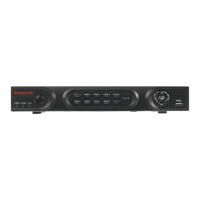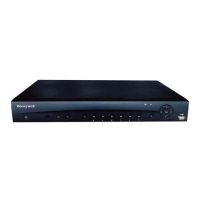
Do you have a question about the Honeywell HRGX161 and is the answer not in the manual?
| Channels | 16 |
|---|---|
| Recording Resolution | Up to 1080p |
| Hard Drive Capacity | Up to 6TB |
| Compression | H.264 |
| Video Output | HDMI, VGA |
| Motion Detection | Yes |
| Video Input | 16 |
| Network Connectivity | Ethernet |
| Remote Viewing | Yes, via mobile app |
Provides an overview of the key features of the HRGX DVR, including general and local monitoring capabilities.
Details the function of each button, LED indicator, and port on the front panel of the HRGX DVR.
Illustrates and describes the function of each connector on the rear panel of the HRGX DVR.
Explains the basic mouse operations for navigating and controlling the HRGX DVR.
Details the layout and functions of the IR remote control for operating the HRGX DVR.
Provides essential safety and environmental guidelines for installing the DVR.
Instructions for connecting cameras, monitors, audio devices, and network.
Step-by-step procedures for safely powering the DVR on and off.
Guides through the initial configuration process using the setup wizard.
Explains how to navigate and access the main menu interface of the DVR.
Instructions for setting the system date and time for accurate event stamping.
Procedures for upgrading the DVR firmware locally or remotely.
Provides a table to estimate storage space usage based on recording bit rate.
Introduction to the DVR's default live view mode and on-screen notifications.
Customizing screen layout and video output modes for live view.
Performing operations like channel switching and digital zoom in live view.
Introduction to controlling PTZ cameras via the DVR's on-screen interface.
Setting up PTZ camera connection parameters like baud rate and protocol.
Programming and executing pre-defined PTZ camera movements.
Manually starting or stopping recordings for specific channels or all channels.
Setting up scheduled recording times and types for channels.
Initiating and managing manual recording sessions for channels.
Setting up special recording configurations for holidays.
Defining video stream resolution, bitrate, and quality for recording.
Setting up dual HDD for simultaneous video saving for redundancy.
Locking video files or setting HDD to read-only to prevent overwriting.
Retrieving and playing back recorded video for a specific camera channel.
Locating and playing back recordings using specific dates and times.
Finding and playing back video related to alarm inputs or motion detection.
Using tags to search for and play back specific video clips.
Creating video clips, working with tags, and using digital zoom during playback.
Saving recorded video files to a USB flash drive or other external storage.
Saving custom video clips created during playback to external storage.
Setting up sensor inputs, alarm types, and handling properties.
Configuring dwell time and handling properties for alarm outputs.
Setting up motion detection areas, sensitivity, and alarm responses.
Setting up detection for video tampering events like lens coverage.
Setting up detection for video loss events and corresponding alarms.
Configuring alarms for device exceptions like HDD errors or network issues.
Setting up email notifications for alarm events or device exceptions.
Configuring notification messages to a remote alarm host (CMS).
Configuring basic network settings like IP address, DHCP, and ports.
Setting up PPPoE, DDNS, NTP, SNMP, UPnP, Multicast, RTSP, and ports.
Monitoring network traffic, testing delay, and exporting network packets.
Checking the operational status of installed hard disk drives.
Expanding storage capacity by adding NAS or SAN devices.
Managing multiple hard drives by setting them up in groups.
Limiting HDD capacity used for storing video from individual cameras.
Performing self-tests on hard drives to determine their health.
Scanning for and potentially repairing bad sectors on hard disk drives.
Setting up alarms for HDD errors or when the drive is full.
Customizing on-screen display text like date, time, and camera name.
Adjusting camera image parameters for different lighting conditions.
Masking specific areas of the video feed to conceal sensitive information.
Adjusting core system parameters like language, resolution, and date/time.
Displaying device, camera, record, alarm, network, and HDD status details.
Managing and analyzing operation, alarm, exception, and HDD log files.
Backing up and restoring DVR configuration settings to/from storage.
Procedures for updating the DVR's operating software via USB or FTP.
Resetting the DVR to its original factory default configurations.
Overview of Administrator, Operator, and Guest user account types and permissions.
Creating new operator or guest user accounts with specific access levels.
Modifying existing user account permissions and details.
Removing user accounts that are no longer needed.
Updating the administrator account password for enhanced security.











